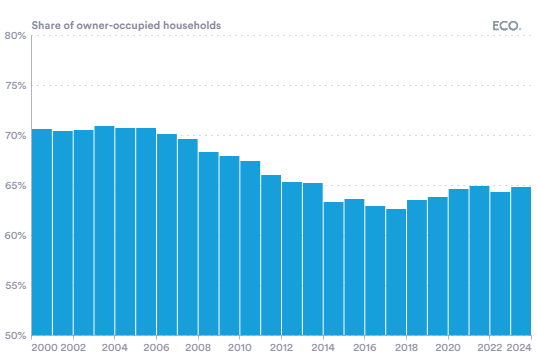With high property prices, rising rents and sluggish rates of new-build, the UK is facing a crisis of housing affordability. A comprehensive strategy is urgently needed, one that’s joined up with other key areas of public policy, including taxation and investment in human capital.
Barely a day goes by without the words ‘housing crisis’ appearing in the news. High interest rates, inflation, wage stagnation and entrenched economic inequality are part of the mix. Declining rates of owner occupation especially among the under-35s, growing mortgage stress and rising rents complete the picture.

Local authorities now acknowledge a duty of prevention or relief to nearly 300,000 homeless households (up by 10% since 2019). They are also spending £1.7 billion per year on ‘temporary’ accommodation (Local Government Association, 2023).

The government seems hopeful, despite passing the parcel regularly from one housing minister to another (six between 2015 and 2020, seven more since). But hope, as they say, is not a plan; and a plan – a comprehensive housing strategy, integrated with itself and joined up with other areas of public policy – is what the UK needs right now.
What policies might work?
First, a meaningful effort to address a longstanding and deeply rooted problem of housing supply would help. The UK has been left trailing in Europe and the OECD in terms of new starts, housing stock that is fit for purpose, and homes per head of the population.

Presently, the government aims to create 300,000 new homes each year. But mandatory targets go in and out of fashion like designer shoes, while politicians debate the relative merits of brownfield and greenfield sites without building on either sufficiently to achieve key goals.
In fact, UK housebuilding peaked in the 1960s and it has never really recovered. Between eye-watering dividends for construction company shareholders, a desperate need for planning reform, and debates around carbon footprints and emissions, there is no quick fix. If nothing else, however, the present hiatus could be used to explore and promote modern methods of construction – recognising their potential to create sustainable, as well as affordable, built environments in quite short periods of time.
Second, the housing system needs a reliable flow of funds. With so little public investment in recent decades, ministerial hopes have been pinned on private finance for everything from funds for lending to housing infrastructure improvements. Of late, institutional investment in the private rental sector has been in vogue, favouring ‘build-to-rent’ over ‘buy-to-let’.
While it is possible that build-to-rent could account for as much as a quarter of the private rental sector by the end of the decade, so far the jury is out: fewer than 100,000 units have been completed (though more than double that may be in the pipeline), and rents and charges are at a premium.
Private finance is, of course, as much about returns to investors, shareholders and executives as it is about meeting a complex range of housing needs at affordable prices. The alternative is tax-funded public investment. In relation to housing, tax is seemingly popular, albeit it via piecemeal surcharges on the purchase, sale and council tax liabilities of second properties and vacant homes.
There are, nevertheless, more effective ways to widen the tax base of housing, such as general wealth taxes or (green) land value taxes. Both would encourage the best and fullest use of the existing stock while releasing the substantial funding streams which UK housing systems have been starved of for too long.
Finally, the present crisis is above all about declining affordability, and this reflects – among other important things – a dramatic long-run change in the shape of the income distribution.

Wage growth in the 1990s and 2000s was barely half that of the 1970s and 1980s. Further wage stagnation followed the global financial crisis of 2007-09. Critically, over that period, as home prices and housing costs rose, the income shares of the top 10% and bottom 50% diverged.
This helps to explain why the proportion of all income (including housing benefit) now spent on housing outlays by the poorest quarter of households is four times as high as that spent by the top 25%.
Part of the solution is a more rational and progressive approach to the taxation of incomes and wealth. But any combination of tactics that increases investment in the education, skills, human capital and financial welfare of the poorest 40% could reduce housing affordability stress. It would also, by most accounts, be good for the economy as a whole.
